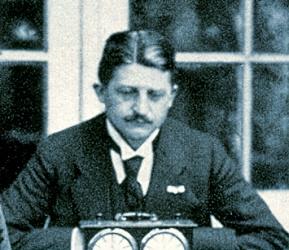
Edward Winter

Carl Carls in 1914
It was in 1983 (C.N. 237) that Chess Notes first discussed the celebrated miniature won by Carl Carls against a player named Schuster. There are many complications, although the game-score itself is not in doubt: 1 e4 c6 2 d4 d5 3 Nc3 dxe4 4 Nxe4 Nf6 5 Ng3 h5 6 Bg5 h4 7 Bxf6 hxg3 8 Be5

8...Rxh2 9 Rxh2 Qa5+ 10 c3 Qxe5+ 11 dxe5 gxh2 12 White resigns.

Firstly, there is the question of where and when Carls won. C.N. 293 indicated that the game was played in a tournament in Oldenburg, 1914, and not 1913 as stated, for instance, in the source quoted in C.N. 237 (page 297 of The Year-Book of Chess 1914 by M.W. Stevens). The occasion is, though, often given as ‘Bremen, 1914’ (e.g. by Pal Benko on page 156 of Chess Life & Review, March 1973 and by Nikolay Minev on page 30 of Inside Chess, 8 March 1993). The moves appeared on pages 167-168 of Deutsches Wochenschach, 10 May 1914. A brief account and the crosstable of the weekend tournament (referred to as ‘der 3. Kongreß des Oldenburgisch-Ostfriesischen Verbandes’ and held on 7-8 March 1914) were supplied on pages 94-95 of the 15 March 1914 issue of the German magazine.

Next, there is the Torre matter. In C.N. 778 we pointed out that on pages 183-184 of 200 Miniature Games of Chess (London, 1941) J. du Mont gave Schuster v Carls (‘Bremen, 1914’) and wrote:
‘Curiously enough, the identical game was played in an off-hand encounter won by Torre in Mexico 15 years later.’
As noted on page 268 of Chess Explorations, the following appeared on page 327 of the August 1929 BCM:

Analytical complications abound. Concerning the final moves, in C.N. 417 W.H. Cozens (Ilminster, England) wrote in connection with Schuster v Carls:
‘This famous old combination ... is unsound. White has only to play 10 Qd2! (instead of 10 c3) and the combination is bust, for after 10...Qxe5+ 11 dxe5 gxh2 12 O-O-O Nd7 13 Nh3 h1(Q) 14 e6 fxe6 15 Be2 Qxg2 16 Bh5+ Kd8 17 Nf4 White wins quickly. 12...Bd7 also loses. Black would have to play (after 10 Qd2) ... Qxd2+ 11 Kxd2 gxh2 12 Bxh2 Bf5 with equality. This was pointed out by G. Porreca in L’Italia Scacchistica in 1953.’
However, in a subsequent item (C.N. 619) we reported:
‘The September 1983 issue of Schacknytt has two pages of pickings from C.N., and the writer, Sixten Johansson, gives a further twist to the Schuster-Carls combination, which was declared unsound in C.N. 417 on account of 10 Qd2. The simple yet curiously unobvious point is that White loses his queen after 10...gxf2+. We learn that E. Böök published the “refutation” of Carls’ combination in his chess column that appeared in a Finnish railwaymen’s magazine, having taken the refutation from Shakhmaty v SSSR in 1964. Some weeks later a correspondent from Lieksa pointed out 10 Qd2 gxf2+, previously overlooked by everybody. Böök mentions that Kurt Richter in Deutsche Schachblätter, 1936 and H.J. van Donk in Schakend Nederland, 1966, also wrongly claimed that the Carls brilliancy was “bust”.’
The game was given (as N.N. v Torre, Mexico, 1928) on page 175 of the July 1964 Chess Life, and a reader of Larry Evans’ column, Vincent Mooney, reverted to it on page 40 of Chess Life & Review, January 1970:
‘Several years ago grandmaster Rossolimo showed me that White should play 10 Q-Q2, and then QxBch 11 PxQ PxR 12 O-O-O! B-Q2 13 P-K6 PxP 14 N-B3 P-R8(Q) 15 B-B4 QxP 16 N-N5!! and it seems White has a won game. Does Black have a better defense: e.g., 15...QxRch – I have tried about six lines and in all of them White seems to have a win, even though he is a bishop and pawn down at the end of move 15, unless 15...QxRch is played?’
Evans replied:
‘Black wins rather easily after 10 Q-Q2 PxPch! followed by 11...QxQch and 12...PxN(Q).’
C.N. 5231 asked whether it was known where the game was ascribed to Torre before publication in the BCM. No such prior appearance has yet been found. As regards Carls’ victory, we commented that there seemed no reason to doubt the above-mentioned statement in Deutsches Wochenschach that the occasion was a tournament in Oldenburg in 1914. On the other hand, Carls also defeated Schuster in the 1913 tournament held there (for the crosstable, see page 242 of the German magazine, 6 July 1913). Schuster, though not Carls, participated in the first Oldenburg tournament too (whose crosstable appeared on page 242 of the 7 July 1912 issue). In none of these, or other, contemporary references have we yet found the forename of Schuster, who, according to page 129 of the 6 April 1913 Deutsches Wochenschach, was from Wilhelmshaven.
The claim that Kurt Richter wrote in the 1936 Deutsche Schachblätter that the Schuster v Carls combination was unsound resulted in additional details being provided in C.N. 5258. The full game was given on page 166 of the 1 June 1936 magazine (at the end of an article on Carls by Alfred Brinckmann), and Alan McGowan (Waterloo, Canada) noted that it was discussed further in an unsigned feature (readers’ reaction) on page 389 of the 1 November 1936 issue:
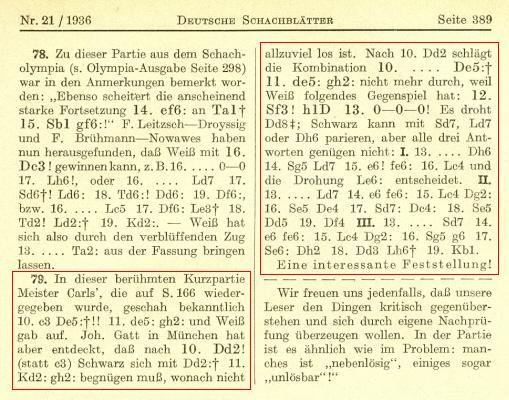
Mr McGowan also pointed out that page 403 of the 15 November 1936 Deutsche Schachblätter reverted to Schuster v Carls, and that this time the possibility of 10...gxf2+ was included:
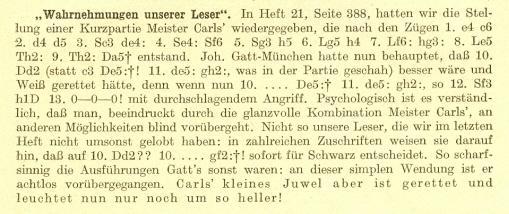
Moreover, further to the claim that Carlos Torre won an identical game in the late 1920s, Christian Sánchez (Rosario, Argentina) offered in C.N. 5258 a further complication by quoting from page 98 of Emil Gelenczei’s book 200 celadas de apertura (whose publishing history was discussed in C.N. 4455):
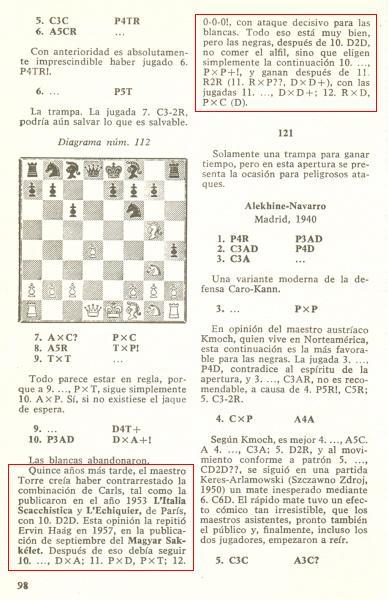
So now the claim, on the basis of two 1953 magazines, is that, 15 years after Schuster v Carls was played, Torre believed that he had refuted the combination with 10 Qd2, overlooking 10...gxf2+. The text does not suggest that Torre played the game himself.
And that, at present, is how matters stand.
Below is a photograph of Carl Carls watching a game in Mannheim in 1914 between Ehrhardt Post and Savielly Tartakower. It is taken from Carl Carls und die “Bremer Partie” by Kurt Richter (Berlin, 1957):
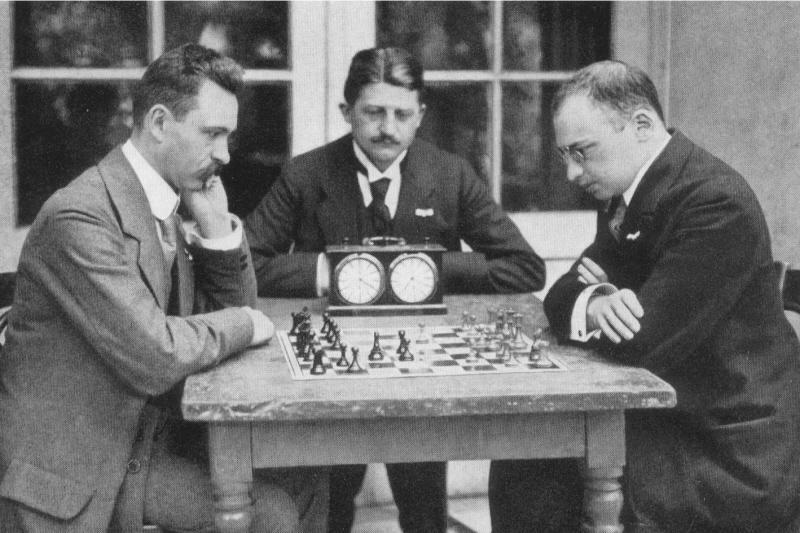
This article originally appeared at ChessBase.com.
See too pages 68-69 of Questions of Modern Chess Theory by Isaac Lipnitsky (Glasgow, 2008).
Alan McGowan (Waterloo, Canada) notes that the moves ‘10 c3 (Dd2, gf2:+)’ were mentioned on pages 211-212 of the November 1931 issue of Schachwart (edited by Kurt Richter):
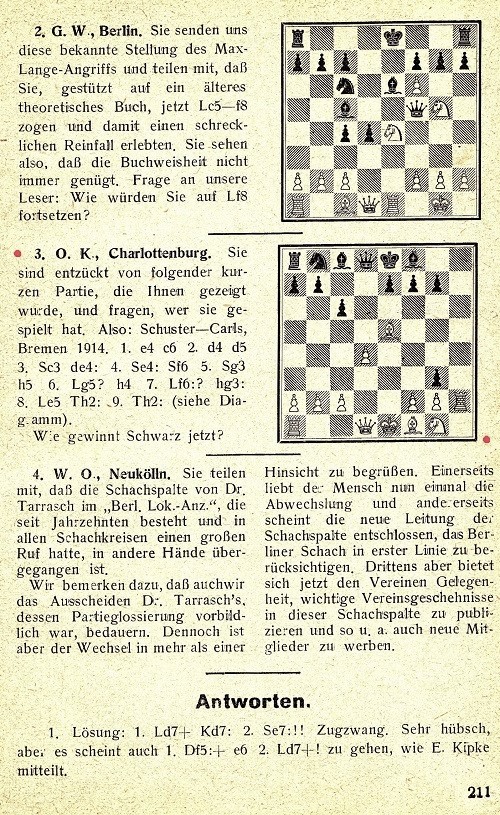

(10400)
To the Chess Notes main page.
To the Archives for other feature articles.
Copyright: Edward Winter. All rights reserved.